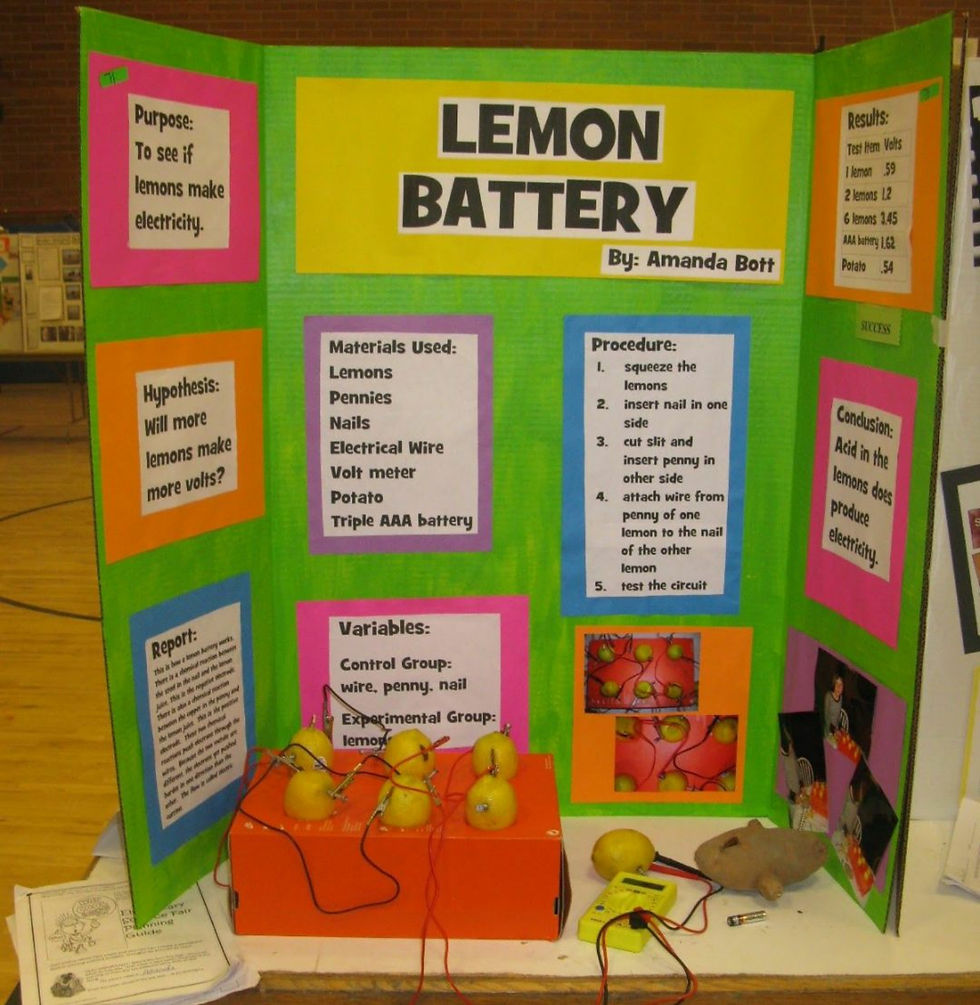#Grade3-5 Science Project #Lemon Battery Experiment
- Thought Feed

- Apr 19, 2020
- 3 min read
Updated: Apr 23, 2020
Lemon Battery Experiment
Objective:
To verify if it is possible to produce electric current using the acidic properties of lemon.
ABSTRACT
The project in its present form is chemical experimentation of lemon can be a battery. The initial idea was to investigate whether lemon can produce electricity or not. Lemon have been the experiment substance because they are such a voltaic cell, which change chemical energy into electrical energy. By using a parallel circuit, a conductor like a copper used firmly insert into the fruit to flow the electrical current and the result measured by using a voltmeter.
Hypothesis
It is possible to produce electric current using the acidic properties of lemon. When you attach two electrodes to a lemon and touch your tongue to both of them at the same time, it completes an electrical circuit, making an electric current pass through the tongue, giving it a tingling sensation or a metallic taste.
Materials
· Lemon
· copper penny
· a galvanized nail
· Wire stripper or clipper
· Voltmeter
Procedure:
How to Make a Lemon Battery
1. Use the wire strippers to strip off about 2.5 inches of plastic insulation from the copper wire. Then cut that piece from the main roll. This serves as the positive electrode or the cathode. If you are using a penny, make a small slit in the lemon with a knife before placing a penny snugly within it with about a third of it exposed.
2. Place the galvanized nail on the other end of lemon. This is the anode or the negative electrode.
3. Use the sandpaper to make the edges of the two electrodes smooth as they would serve as the junction points of the electrical circuit.
4. Roll the lemon gently on a table to loosen the soft pulp and allow the juice to flow inside. Be careful not to rupture the skin of the lemon, though.
5. Insert the copper wire by 1 inch into the lemon.
6. After ensuring that your tongue is moist with saliva, touch it to the copper wire. Make an observation regarding what you feel.
7. Insert the paper clip, zinc strip or nail into the lemon keeping a distance of ¼th inch from the first insertion point. Ensure that the two electrodes do not touch each other at any point.
8. Now, make contact with your moist tongue to both the exposed ends of the electrodes at the same time. Make an observation again regarding the sensation in your tongue.
How Many Volts Does a Lemon Battery Produce
It depends on what metal wire you are using for the anode and cathode. You can take notes of the amount of voltage produced by using different wires so you can monitor the outcome in future.
Though the voltage produced in this experiment is near about a volt that is well within safety limits, those of you who do not desire any physical contact with the equipment can test the electric current and voltage by connecting a multimeter to the electrodes. They need to connect the leads of the device with the lemon battery with the help of alligator clips.
How Does a Lemon Battery Work?
A battery converts chemical energy into electrical energy. The electrodes here are made to come into contact with the lemon juice that is nothing but citric acid, an electrolyte. As a result, a chemical reaction ensues and electrons start to get accumulated at the anode. However, positive charges build up at the cathode. As soon as a conducting material (your tongue) establishes a connection between the electrodes, the electrons get a chance to flow from the cathode to the anode forming an electric current. When you touch your tongue to the copper wire only, before connecting the zinc strip, no reaction occurs. Hence, you feel nothing on your tongue in the absence of electric current.
Lemon Battery Diagram

Include a Data Table:
S.No Number of Lemons Voltmeter Reading
Conclusion:
This is how a battery works. There is a chemical reaction between the steel in nail and lemon juice. This is the negative electrode. There is also a chemical reaction between copper in penny and lemon juice. This is the positive electrode.
These two chemical reactions push electrons through wires. Because 2 materials are different. The electrons get pushed harder in one direction than the other. The flow is called current.
Hence it is possible to produce electric current using the acidic properties of lemon.




Comments